Ankylosing spondylitis (also known as Bechterew’s disease or Marie-Strümpell disease) is a seronegative spondyloarthropathy characterized by chronic and indolent inflammation of the axial skeleton. Severe disease can lead to fusion and rigidity of the spine. Ankylosing spondylitis is most often seen in young men and is strongly associated with HLA-B27. Patients will have progressive back pain (which improves with activity), morning stiffness, and decreased range of motion of the spine. Extra-articular manifestations include fatigue, enthesitis, anterior uveitis, restrictive lung disease, and inflammatory bowel disease. The diagnosis is based on the clinical history, physical exam, and imaging demonstrating sacroiliitis and bridging syndesmophytes. Most patients are managed with physical therapy and nonsteroidal anti-inflammatory drugs (NSAIDs). More severe cases may require tumor necrosis factor-alpha inhibitors or surgery.
Last updated: Dec 15, 2025
Ankylosing spondylitis Ankylosing spondylitis Ankylosing spondylitis (also known as Bechterew’s disease or Marie-Strümpell disease) is a seronegative spondyloarthropathy characterized by chronic and indolent inflammation of the axial skeleton. Severe disease can lead to fusion and rigidity of the spine. Ankylosing Spondylitis (AS) is a seronegative spondyloarthropathy Spondyloarthropathy Ankylosing Spondylitis characterized by chronic and indolent inflammation Inflammation Inflammation is a complex set of responses to infection and injury involving leukocytes as the principal cellular mediators in the body’s defense against pathogenic organisms. Inflammation is also seen as a response to tissue injury in the process of wound healing. The 5 cardinal signs of inflammation are pain, heat, redness, swelling, and loss of function. Inflammation of the axial Axial Computed Tomography (CT) skeleton.
To remember the seronegative spondyloarthropathies Spondyloarthropathies Examination of the Lower Limbs, use the mnemonic “PAIR.”
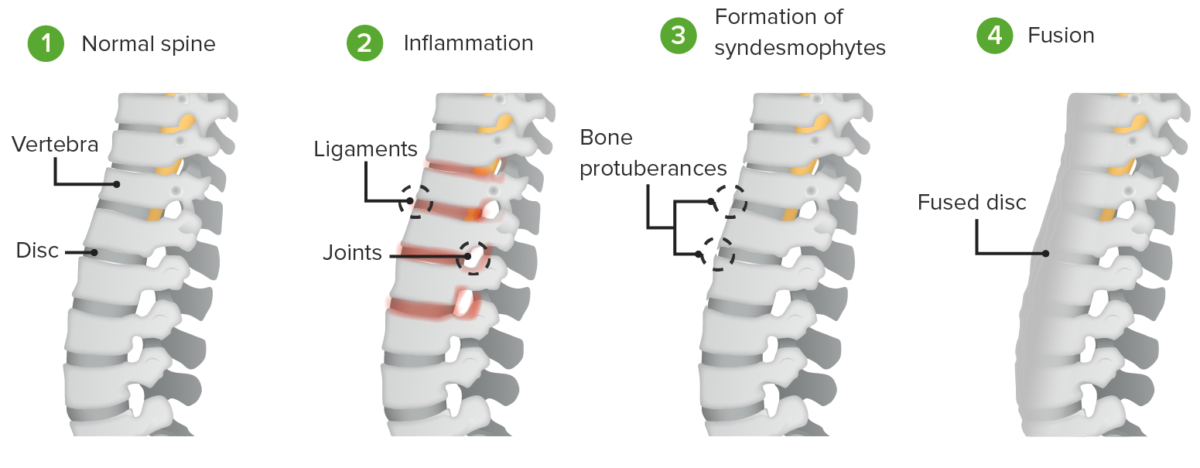
Pathogenesis of ankylosing spondylitis:
Inflammation induces the formation of syndesmophytes and the fusion of the intervertebral discs and vertebral bodies.
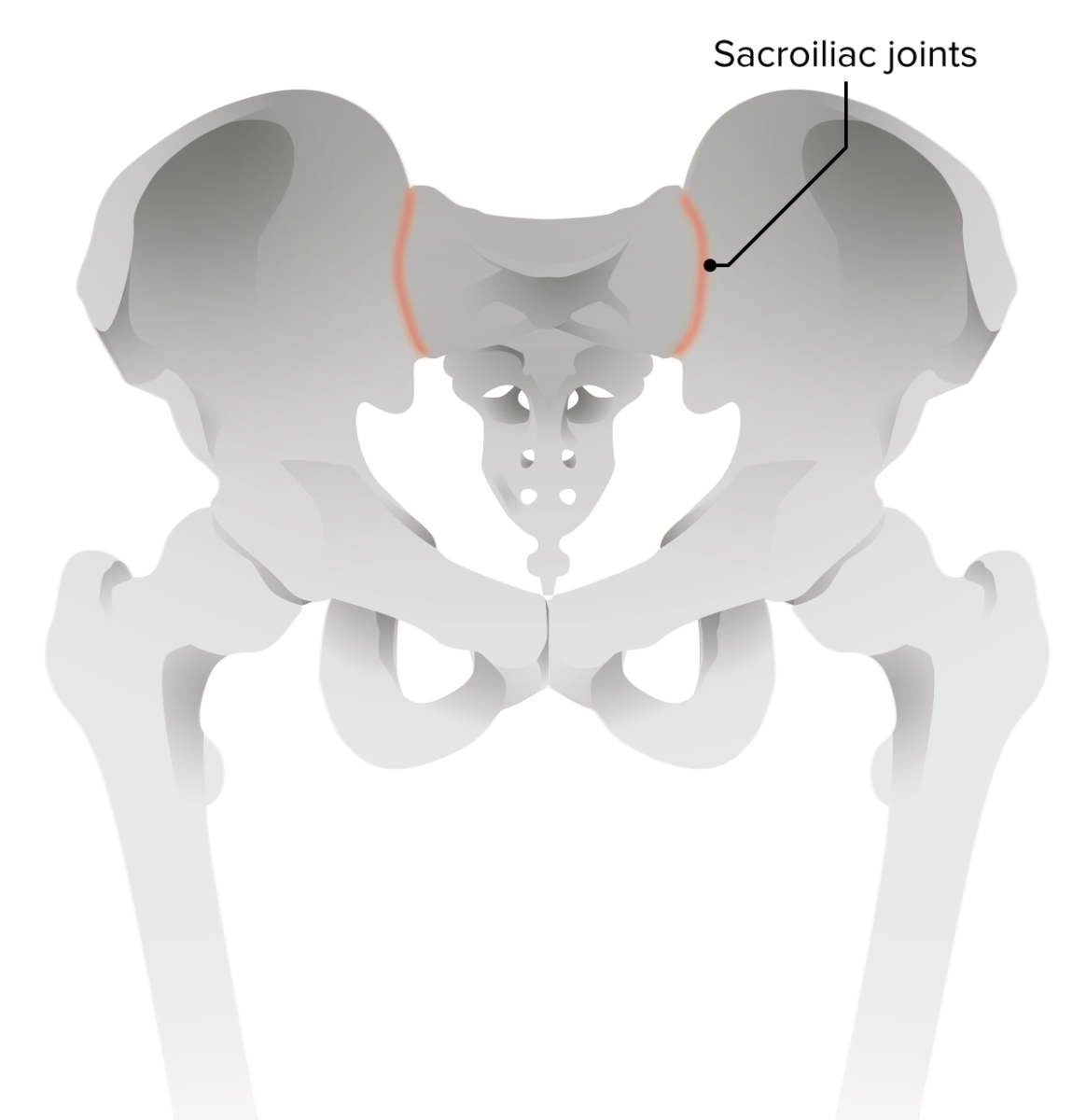
Pathogenesis of ankylosing spondylitis:
Erosion of the iliac side of sacroiliac joints is the earliest radiologic sign of ankylosing spondylitis.
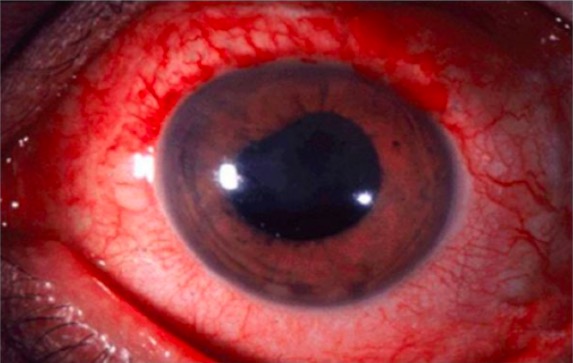
Anterior uveitis is a common extra-articular manifestation of ankylosing spondylitis.
Image: “Anterior uveitis” by Christopher J. Gilani et al. License: CC BY 4.0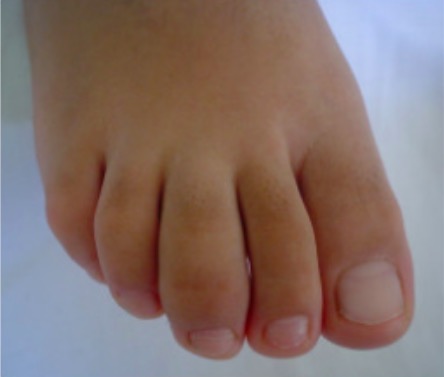
Dactylitis of the 3rd digit in ankylosing spondylitis
Image: “Involvement of the feet in patients with SpA” by Department of Rheumatology, Hospital General de México, Faculty of Medicine, Universidad Nacional Autónoma de México, Dr, Balmis 148, Colonia Doctores, México, DF 06720, Mexico. License: CC BY 2.0, cropped by Lecturio.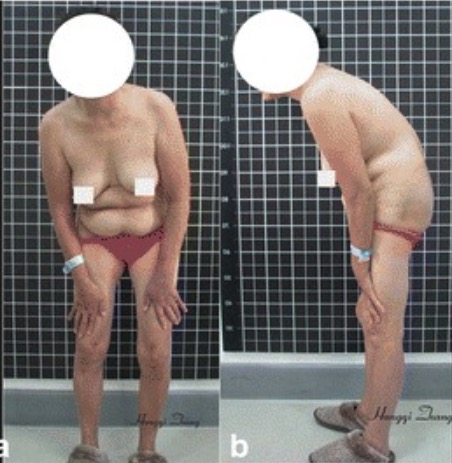
Stooped, forward-flexed position in a patient with ankylosing spondylitis
Image: “Preoperative imaging” by Hongqi Zhang et al. License: CC BY 4.0, cropped by Lecturio.Refer patients Patients Individuals participating in the health care system for the purpose of receiving therapeutic, diagnostic, or preventive procedures. Clinician–Patient Relationship with the following clinical features to a rheumatologist:
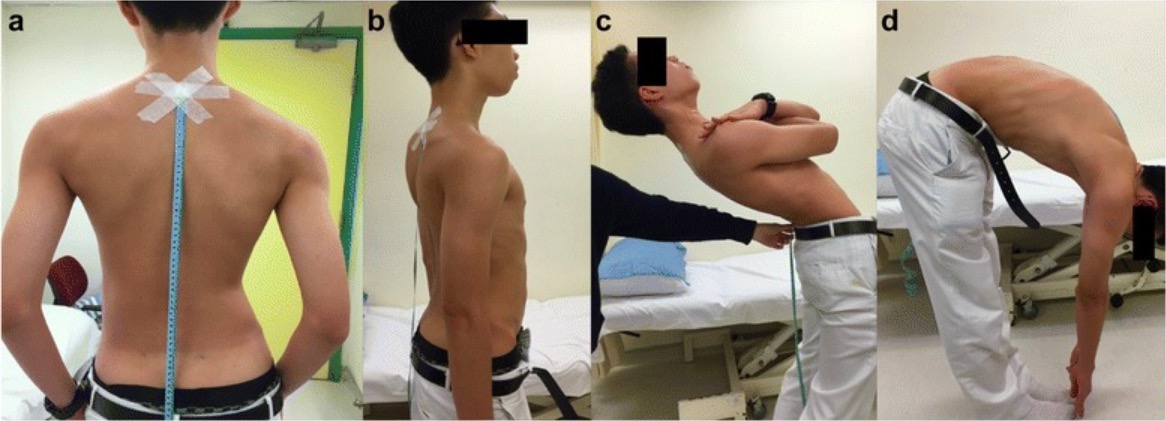
The Schober test: a photograph of a patient demonstrating the Schober test for spinal mobility. After the marks are placed 10 cm and 5 cm away from the spinal process of L5, the patient is asked to bend over. If distance does not increase by > 5 cm, the patient has reduced lumbar flexion indicative of ankylosing spondylitis.
Image: “Schober test” by Kamil Eyvazov et al. License: CC BY 4.0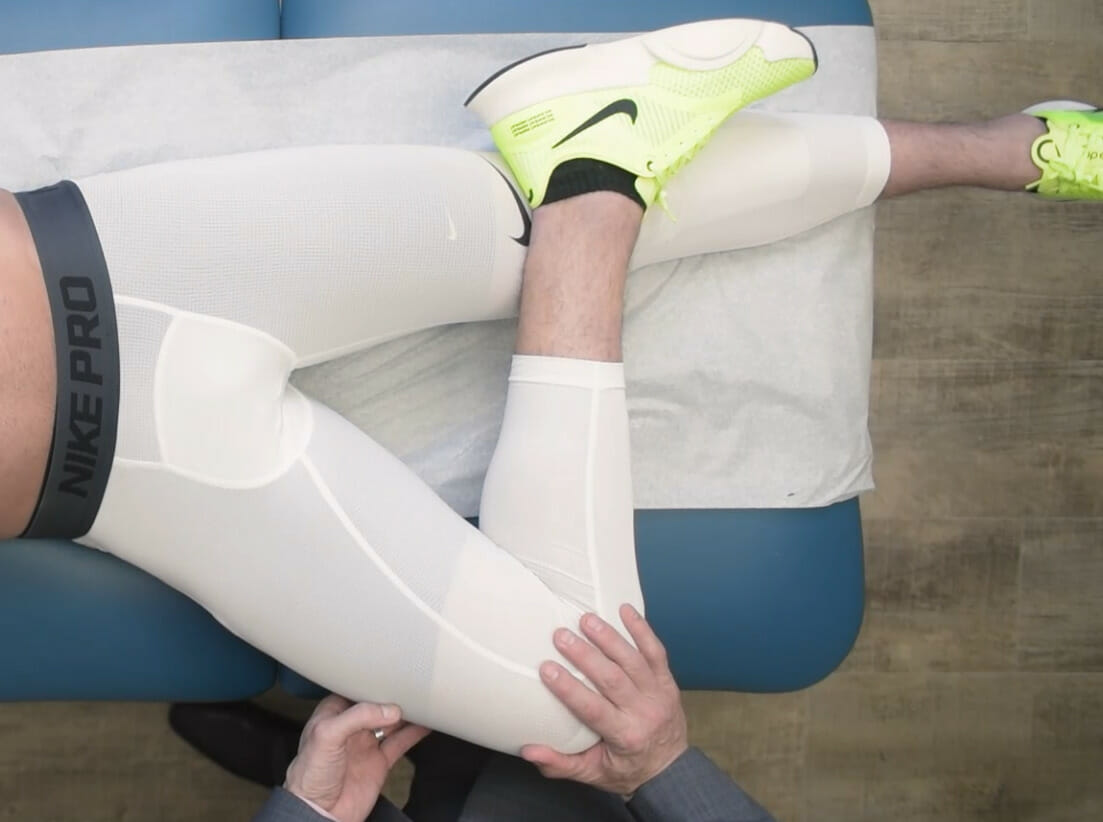
The FABER test:
This test may be used to detect hip, lumbar, or sacroiliac joint pathology. These signs are often positive in ankylosing spondylitis.
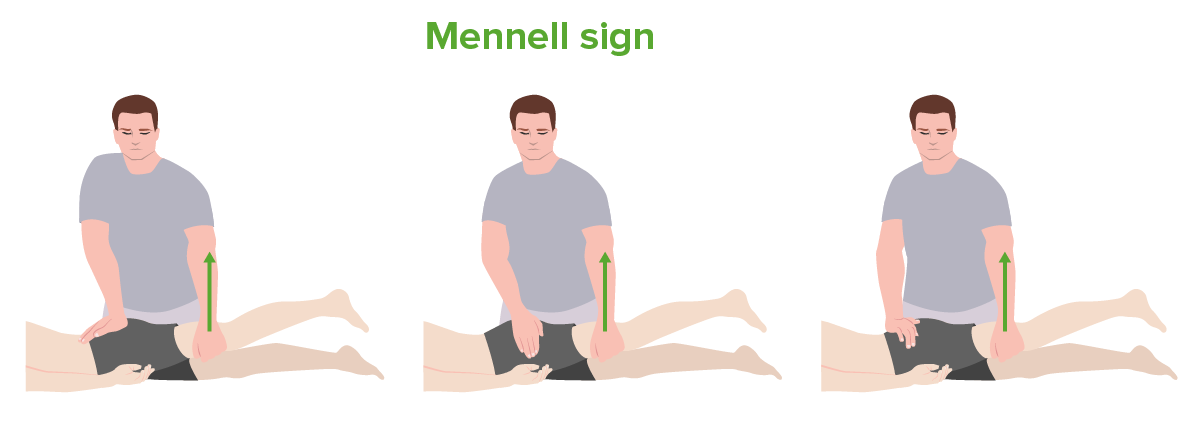
The Mennell sign:
From left to right: testing of the sacroiliac joint, hip joint, and lumbar spine. This test may be used in the evaluation for ankylosing spondylitis.
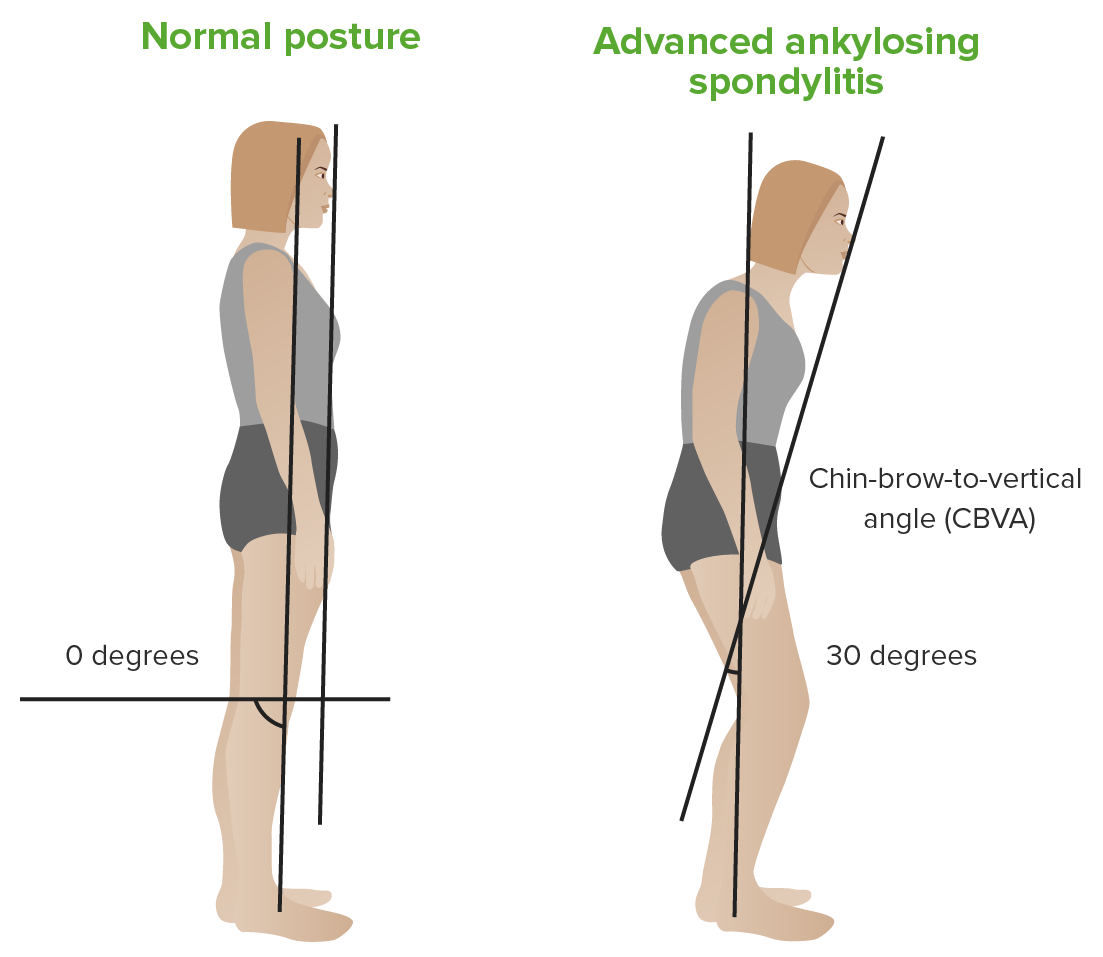
Chin–brow vertical angle:
Left: patient with a normal back
Right: patient with ankylosing spondylitis
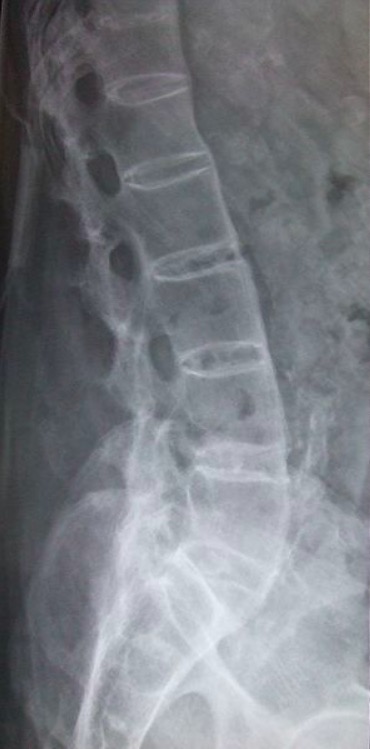
Lateral lumbar spine radiograph in ankylosing spondylitis:
This image demonstrates squaring of the vertebrae with a “bamboo stick” appearance due to bridging syndesmophytes.
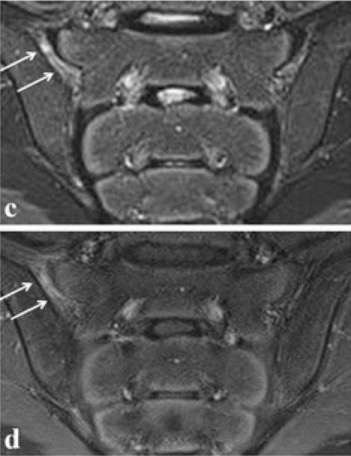
MRI of the sacroiliac joint in ankylosing spondylitis:
The arrows point to enhancement of the right sacroiliac joint, indicating sacroiliitis.
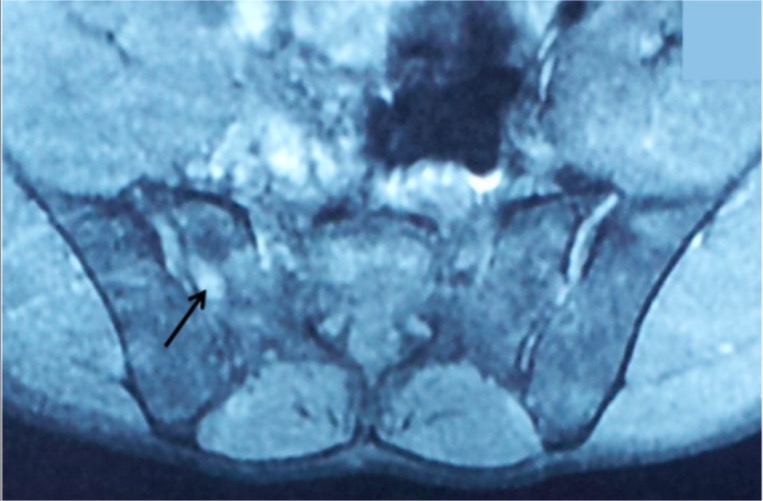
MRI of the sacroiliac joints in ankylosing spondylitis:
This image shows bilateral sacroiliitis with a hyperintense signal on T2 (arrow) at the SI joint.
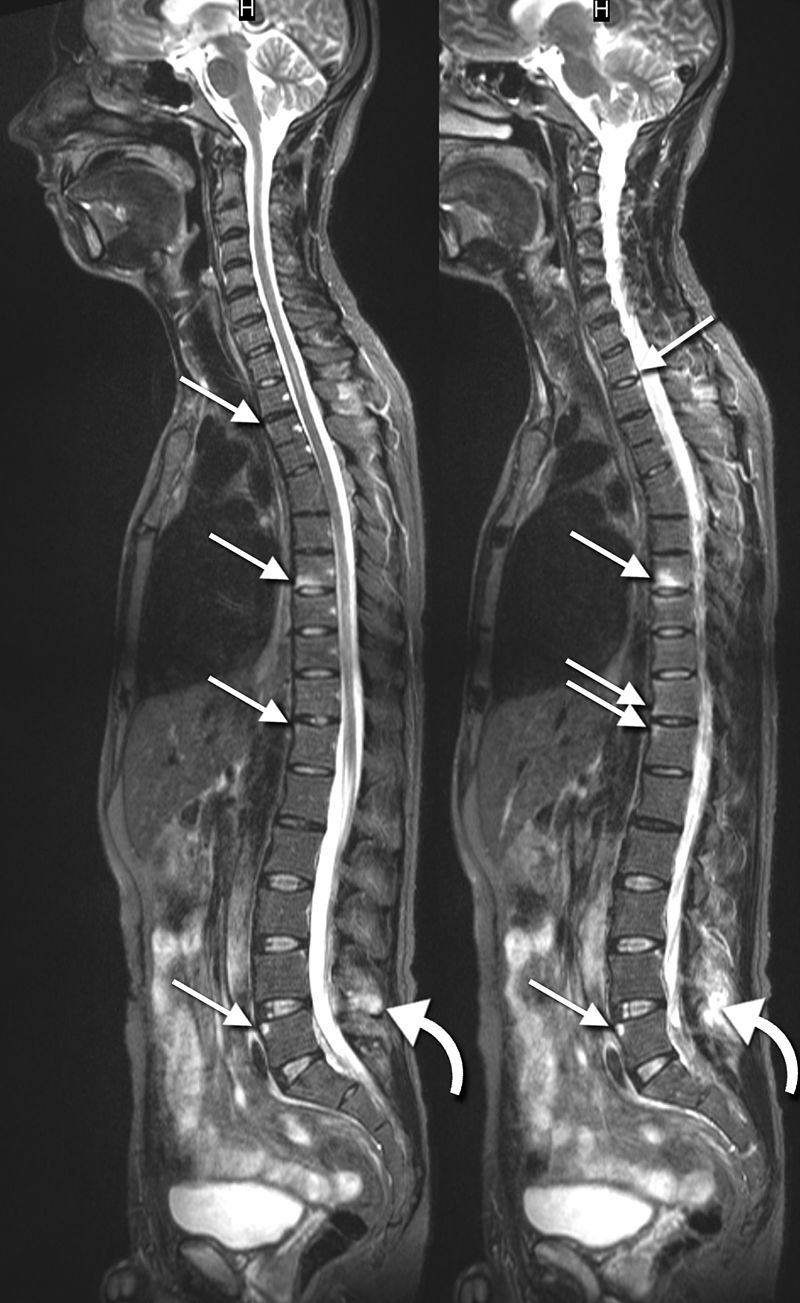
Sagittal MRIs in ankylosing spondylitis:
These images show inflammatory lesions in the thoracic and lumbar spine (arrows). Inflammatory lesions of the spinous process are also shown at L4 (curved arrows).
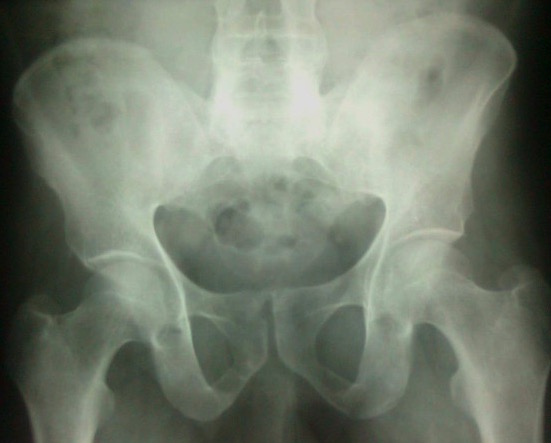
Radiograph of the pelvis in ankylosing spondylitis:
This image demonstrates advanced sacroiliitis with fusion of the SI joints.
Management requires a multidisciplinary approach to reduce pain Pain An unpleasant sensation induced by noxious stimuli which are detected by nerve endings of nociceptive neurons. Pain: Types and Pathways, increase range of motion Range of motion The distance and direction to which a bone joint can be extended. Range of motion is a function of the condition of the joints, muscles, and connective tissues involved. Joint flexibility can be improved through appropriate muscle strength exercises. Examination of the Upper Limbs, decrease inflammation Inflammation Inflammation is a complex set of responses to infection and injury involving leukocytes as the principal cellular mediators in the body’s defense against pathogenic organisms. Inflammation is also seen as a response to tissue injury in the process of wound healing. The 5 cardinal signs of inflammation are pain, heat, redness, swelling, and loss of function. Inflammation, and improve quality Quality Activities and programs intended to assure or improve the quality of care in either a defined medical setting or a program. The concept includes the assessment or evaluation of the quality of care; identification of problems or shortcomings in the delivery of care; designing activities to overcome these deficiencies; and follow-up monitoring to ensure effectiveness of corrective steps. Quality Measurement and Improvement of life.
Management by a rheumatologist, in coordination Coordination Cerebellar Disorders with a multidisciplinary team, is recommended.
Initial therapy:[13–15,20]
2nd line:
3rd line (unresponsive to TNFi): use another TNFi or use IL-17 inhibitors IL-17 inhibitors Ankylosing Spondylitis[14,15]
Diagnosis Codes:
This code is used to diagnose
ankylosing spondylitis
Ankylosing spondylitis
Ankylosing spondylitis (also known as Bechterew’s disease or Marie-Strümpell disease) is a seronegative spondyloarthropathy characterized by chronic and indolent inflammation of the axial skeleton. Severe disease can lead to fusion and rigidity of the spine.
Ankylosing Spondylitis, a chronic inflammatory
arthritis
Arthritis
Acute or chronic inflammation of joints.
Osteoarthritis that primarily affects the sacroiliac joints and the
spine
Spine
The human spine, or vertebral column, is the most important anatomical and functional axis of the human body. It consists of 7 cervical vertebrae, 12 thoracic vertebrae, and 5 lumbar vertebrae and is limited cranially by the skull and caudally by the sacrum.
Vertebral Column: Anatomy, leading to stiffness and fusion.
| Coding System | Code | Description |
|---|---|---|
| ICD-10-CM | M45.- | Ankylosing spondylitis Ankylosing spondylitis Ankylosing spondylitis (also known as Bechterew’s disease or Marie-Strümpell disease) is a seronegative spondyloarthropathy characterized by chronic and indolent inflammation of the axial skeleton. Severe disease can lead to fusion and rigidity of the spine. Ankylosing Spondylitis (with site specification) |
| SNOMED CT | 63432003 | Ankylosing spondylitis Ankylosing spondylitis Ankylosing spondylitis (also known as Bechterew’s disease or Marie-Strümpell disease) is a seronegative spondyloarthropathy characterized by chronic and indolent inflammation of the axial skeleton. Severe disease can lead to fusion and rigidity of the spine. Ankylosing Spondylitis (disorder) |
Evaluation & Workup:
These codes are for tests used to support the diagnosis, including
X-rays
X-rays
X-rays are high-energy particles of electromagnetic radiation used in the medical field for the generation of anatomical images. X-rays are projected through the body of a patient and onto a film, and this technique is called conventional or projectional radiography.
X-rays or MRI of the sacroiliac joints to look for
sacroiliitis
Sacroiliitis
Inflammation of the sacroiliac joint. It is characterized by lower back pain, especially upon walking, fever, uveitis; psoriasis; and decreased range of motion. Many factors are associated with and cause sacroiliitis including infection; injury to spine, lower back, and pelvis; degenerative arthritis; and pregnancy.
Ankylosing Spondylitis, and a blood test for the HLA-B27 genetic marker.
| Coding System | Code | Description |
|---|---|---|
| CPT | 72120 | Radiologic examination, lumbosacral spine Spine The human spine, or vertebral column, is the most important anatomical and functional axis of the human body. It consists of 7 cervical vertebrae, 12 thoracic vertebrae, and 5 lumbar vertebrae and is limited cranially by the skull and caudally by the sacrum. Vertebral Column: Anatomy; 2 or 3 views |
| CPT | 86812 | HLA typing; A, B, or C, single antigen Antigen Substances that are recognized by the immune system and induce an immune reaction. Vaccination |
Medications:
These codes are for the medications used to manage
ankylosing spondylitis
Ankylosing spondylitis
Ankylosing spondylitis (also known as Bechterew’s disease or Marie-Strümpell disease) is a seronegative spondyloarthropathy characterized by chronic and indolent inflammation of the axial skeleton. Severe disease can lead to fusion and rigidity of the spine.
Ankylosing Spondylitis.
NSAIDs
NSAIDS
Primary vs Secondary Headaches are the first-line treatment for
pain
Pain
An unpleasant sensation induced by noxious stimuli which are detected by nerve endings of nociceptive neurons.
Pain: Types and Pathways and stiffness, while biologic
TNF inhibitors
TNF inhibitors
Ankylosing Spondylitis like
adalimumab
Adalimumab
A humanized monoclonal antibody that binds specifically to tnf-alpha and blocks its interaction with endogenous tnf receptors to modulate inflammation. It is used in the treatment of rheumatoid arthritis; psoriatic arthritis; Crohn’s disease and ulcerative colitis.
Disease-Modifying Antirheumatic Drugs (DMARDs) are used for more severe, active disease.
| Coding System | Code | Description |
|---|---|---|
| RxNorm | 7294 | Naproxen Naproxen An anti-inflammatory agent with analgesic and antipyretic properties. Both the acid and its sodium salt are used in the treatment of rheumatoid arthritis and other rheumatic or musculoskeletal disorders, dysmenorrhea, and acute gout. Nonsteroidal Antiinflammatory Drugs (NSAIDs) (ingredient) |
| RxNorm | 141533 | Adalimumab Adalimumab A humanized monoclonal antibody that binds specifically to tnf-alpha and blocks its interaction with endogenous tnf receptors to modulate inflammation. It is used in the treatment of rheumatoid arthritis; psoriatic arthritis; Crohn’s disease and ulcerative colitis. Disease-Modifying Antirheumatic Drugs (DMARDs) (ingredient) |
Complications:
These codes document common extra-articular manifestations of
ankylosing spondylitis
Ankylosing spondylitis
Ankylosing spondylitis (also known as Bechterew’s disease or Marie-Strümpell disease) is a seronegative spondyloarthropathy characterized by chronic and indolent inflammation of the axial skeleton. Severe disease can lead to fusion and rigidity of the spine.
Ankylosing Spondylitis, including
inflammation
Inflammation
Inflammation is a complex set of responses to infection and injury involving leukocytes as the principal cellular mediators in the body’s defense against pathogenic organisms. Inflammation is also seen as a response to tissue injury in the process of wound healing. The 5 cardinal signs of inflammation are pain, heat, redness, swelling, and loss of function.
Inflammation of the eye (anterior
uveitis
Uveitis
Uveitis is the inflammation of the uvea, the pigmented middle layer of the eye, which comprises the iris, ciliary body, and choroid. The condition is categorized based on the site of disease; anterior uveitis is the most common.
Diseases of the Uvea) and cardiac complications like aortic insufficiency.
| Coding System | Code | Description |
|---|---|---|
| ICD-10-CM | H20.00 | Unspecified acute and subacute iridocyclitis Iridocyclitis Acute or chronic inflammation of the iris and ciliary body characterized by exudates into the anterior chamber, discoloration of the iris, and constricted, sluggish pupil. Symptoms include radiating pain, photophobia, lacrimation, and interference with vision. Relapsing Fever |
| ICD-10-CM | I35.1 | Nonrheumatic aortic (valve) insufficiency |